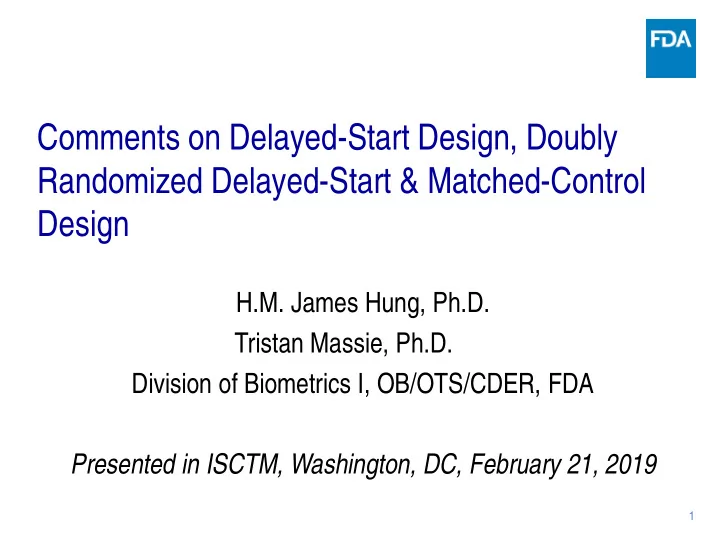

Comments on Delayed-Start Design, Doubly Randomized Delayed-Start & Matched-Control Design H.M. James Hung, Ph.D. Tristan Massie, Ph.D. Division of Biometrics I, OB/OTS/CDER, FDA Presented in ISCTM, Washington, DC, February 21, 2019 1
Disclaimer This sharing presentation reflects only the preliminary thoughts of the authors and should not be construed to represent FDA’s views or policies. 2
Delayed Start Design T T d2 d1 T C t * Part 2 Part 1 DM Leber (1997) 3
Delayed Start Design Differential/early dropouts • - trt arms comparable at baseline of P2? - handling missing data Non-inferiority margin • - population or patient level? - response linear over time? - slope? final time point? - lack of knowledge of rate of change …….. etc; see summary by Dr. Turkoz 4
DRDS-MC: T effect on DP w/ DM T C T d31 d2 T d3 C d32 C t * Part 2 Part 3 DP Extended DP and DM Turkoz et al (2018) 5
DRDS-MC: T effect on DP w/o DM T C T d31 T d2 d3 C d32 C t 23 Part 2 Part 3 DP Extended DP but DM (?) Turkoz et al (2018) 6
D-R Delayed-Start with M-C Control lead-in screens out some • dropouts NI margin - conditional on the size of • treatment effect in Part II (DP) & others - probably more sensible than a fixed margin on treatment effect in Part III - if the size of treatment effect in Part II is not large, why care? 7
Statistical Challenges to DSDs Estimand (ICH E9 R1) • Differential/early dropouts • - trt arms comparable at baseline of P3? - handling missing data NI margin • - population or patient level? - response linear over time? - slope? final time point? - lack of knowledge of rate of change 8
Statistical Challenges to DSDs NI margin for ratio d31/d2 • d31: TT – CT at end of extended DP / DM d2: T – C at end of “DP” - min ratio to test needs to be prespecified at the initial design stage? (not at the interim analysis after seeing the estimated d2) - once passing the min ratio, can test any larger ratio with no alpha adjustment 9
Statistical Challenges to DSDs Missing data • - dropouts may need to be assigned “treatment failure” - d31 (Part 3 difference: TT – CT) and d2 (Part 2 difference: T – C) are estimated by two different sets of patients 10
Statistical Challenges • Rerandomization – C entering part III may be a different group than those randomized to C in part II • Design Asymmetry between T and C in part III – Estimation of d32 at expense of precision of d31 and both could be biased if differential or significant control dropouts in Part II • What happened to the original concept of parallelism? – The difference at the last time point may miss a trend towards convergence 11
Statistical Challenges • Any comparative evidence Bayesian approach is better for delayed start designs? – model averaging seems to require a major paradigm shift – Use of Splines places minimum number of visits constraint on the design – Justification of priors could be an issue • Presented Simulation Results for Scenario 2D – Model Averaging Credible Intervals have zero length which seems Incredible • What about bias-variance tradeoff? 12
Statistical Challenges • Managed withdrawal with re-entry (slide 18)? – this created a complicated analysis issue for ADAGIO trial in Parkinson’s disease • Could be hard to distinguish symptomatic effects of managed withdrawal from DM effects of experimental therapy in short term on a symptomatic efficacy measure 13
Recommend
More recommend